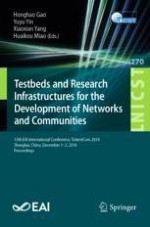2019 | Buch
Testbeds and Research Infrastructures for the Development of Networks and Communities
13th EAI International Conference, TridentCom 2018, Shanghai, China, December 1-3, 2018, Proceedings
herausgegeben von: Honghao Gao, Yuyu Yin, Xiaoxian Yang, Huaikou Miao
Verlag: Springer International Publishing
Buchreihe : Lecture Notes of the Institute for Computer Sciences, Social Informatics and Telecommunications Engineering
